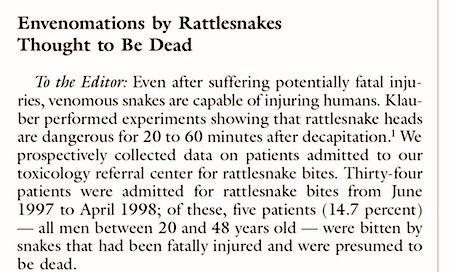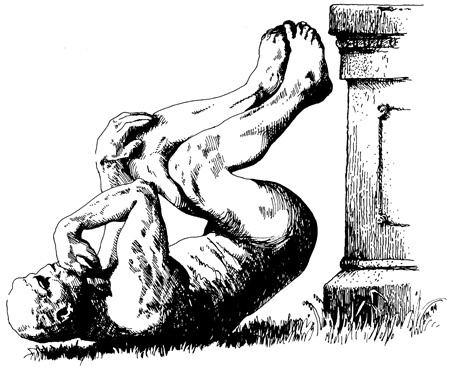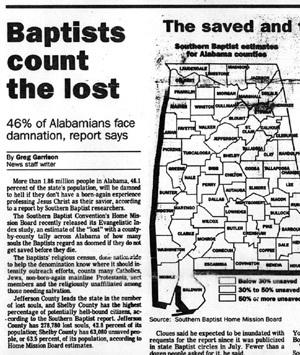Marc Abrahams's Blog, page 183
June 10, 2018
Envenomations by Rattlesnakes Thought to Be Dead, Then and Now
Old rattlesnake research gains new bite, with the news reports of a man who decapitated a rattlesnake, and then was bitten by the detorsoed snake head [“Texas Man’s Near-Fatal Lesson: A Decapitated Snake Can Still Bite” — New York Times].
The most pertinently focussed study was published almost 20 years ago:
“Envenomations by Rattlesnakes Thought to Be Dead,” Jeffrey R. Suchard and Frank LoVecchio, New England Journal of Medicine, vol. 340, no. 24, 1999, p. 1930. The authors, at Good Samaritan Regional Medical Center Phoenix, Arizona, report:
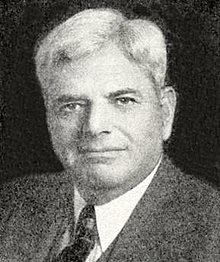
Laurence M. Klauber, who experimented with dead rattlesnakes.
Klauber [Rattlesnakes: Their Habits, Life Histories, and Influence on Mankind, Lawrence M. Klauber, 2nd ed., Berkeley: University of California Press, 1972, pp. 341-349.] performed experiments showing that rattlesnake heads are dangerous for 20 to 60 minutes after decapitation. We prospectively collected data on patients admitted to our toxicology referral center for rattlesnake bites. Thirty-four patients were admitted for rattlesnake bites from June 1997 to April 1998; of these, five patients (14.7 percent) — all men between 20 and 48 years old — were bitten by snakes that had been fatally injured and were presumed to be dead….
Patient 3 shot and then decapitated a rattlesnake. His right index finder was envenomated when he picked up the head. He developed a self-limited coagulopathy but ultimately required finger amputation because of local tissue destruction. Patient 4 was envenomated on his left ring finger and right index finger by a decapitated rattlesnake head that had been motionless for five minutes.
BONUS (related): The 1994 Ig Nobel Prize for medicine was awarded in two parts. First, to Patient X, formerly of the US Marine Corps, valiant victim of a venomous bite from his pet rattlesnake, for his determined use of electroshock therapy — at his own insistence, automobile sparkplug wires were attached to his lip, and the car engine revved to 3000 rpm for five minutes. Second, to Dr. Richard C. Dart of the Rocky Mountain Poison Center and Dr. Richard A. Gustafson of The University of Arizona Health Sciences Center, for their well-grounded medical report: “Failure of Electric Shock Treatment for Rattlesnake Envenomation.” [Published in Annals of Emergency Medicine, vol. 20, no. 6, June 1991, pp. 659-61.] Here is a snippet from the paper, showing Patient X after his life was saved:

Ig Nobel TICKETS will go on sale one month from today
TICKETS for the 28th First Annual Ig Nobel Prize Ceremony will go on sale exactly one month from today: on TUESDAY, JULY 10, 2018.
Tickets will be available exclusively from the Harvard Box Office.

June 9, 2018
Did You Smell the Coffee? [In the Footsteps of the Invisible Gorilla]
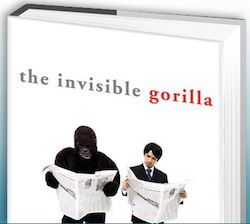
Charles Spence (Ig Nobel Prize winner for the electronically-modified-sound-of-a-potato-chip experiment) and a colleague have a new study that explores an unexplored aspect—smell—of what’s known as “inattentional blindness.’ Inattentional blindness became widely noticed because of the “invisible gorilla experiment” that won an Ig Nobel Prize for Chris Chabris and Dan Simons.
 The new study asks, in essence, “Did you smell the coffee?” The study is:
The new study asks, in essence, “Did you smell the coffee?” The study is:
” ‘What smell?’ Temporarily loading visual attention induces a prolonged loss of olfactory awareness,” Sophie Forster and Charles Spence, Psychological Science, epub 2018. The authors report:
To test whether visual load also modulates olfactory awareness, participants [did a visual search task], while exposed to the ambient aroma of coffee. Immediately upon completion of the task, participants were taken to a different room and given a series of probes designed to elicit report of the olfactory stimulus, before being asked directly if they had noticed it. We predicted that the visual load of the task performed by the participants would predict awareness of the coffee aroma, with those in the high load condition having increased susceptibility to inattentional anosmia….
Only a minority (30%) of the participants… mentioned the coffee aroma in their room description, even though they were describing the room while still exposed to this smell and (as in previous experiments) were asked to use all of their senses in the description. When asked more specifically whether they noticed any smells or odors in the room, only one further participant reported the coffee smell….
Critically, the likelihood that a participant would notice the smell of coffee was significantly, and substantially, influenced by the visual demands of the search task that they performed.
BONUS: Further info about this, from the University of Sussex, notice-the-coffee-smell researcher Sophie Forster’s home base.
BONUS: Here’s historic video of Chabris and Simons’s gorilla experiment:

How Many People Will Go to Hell [mathematics]
The 1994 Ig Nobel Prize for mathematics was awarded to the Southern Baptist Church of Alabama, mathematical measurers of morality, for their county-by-county estimate of how many Alabama citizens will go to Hell if they don’t repent.
Click here for additional details, including a method to calculate your chance of going to hell.

June 8, 2018
“Fake dog testicles made this man a millionaire”
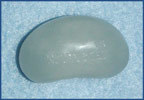 Ig Nobel Prize winner Gregg A. Miller and his doggone—well, dogpartiallygone—invention, Neuticles, are profiled by CNBC, with the headline “Fake dog testicles made this man a millionaire“:
Ig Nobel Prize winner Gregg A. Miller and his doggone—well, dogpartiallygone—invention, Neuticles, are profiled by CNBC, with the headline “Fake dog testicles made this man a millionaire“:
 The 2005 Ig Nobel Prize for medicine was awarded to Gregg A. Miller of Oak Grove, Missouri, for inventing Neuticles—artificial replacement testicles for dogs, available in three sizes, and three degrees of firmness.
The 2005 Ig Nobel Prize for medicine was awarded to Gregg A. Miller of Oak Grove, Missouri, for inventing Neuticles—artificial replacement testicles for dogs, available in three sizes, and three degrees of firmness.
Since that time, Miller has expanded the range of sizes, firmnesses, and body parts.
Miller’s work is documented in US Patent #5868140, and in the book Going Going NUTS!, by Gregg A. Miller, PublishAmerica, 2004, ISBN 1413753167.

June 7, 2018
The Hairy Ball Theorem revisited – a newer, shorter, proof
Once proved, mathematical theorems* tend to stay proved. Nevertheless, they can sometimes still be improved – say, by making them shorter. Take, for example proofs for The Hairy Ball Theorem.
Mathematician Henri Poincaré first drew attention to the Hairy Ball Theorem in 1885 with his treatise ‘Sur les courbes définies par les équations différentielles (III)’ Journal de mathématiques pures et appliquées, 4e série, tome 1 (1885), p. 167-244. It took roughly 27 years, however, for the first formal proof, which was revealed by L. E. J. Brouwer (a.k.a. ‘Bertus’) in ‘Über Abbildung von Mannigfaltigkeiten’ December 1912, Volume 71, Issue 4, pp 598–59.
Now a new (shorter) proof has been provided by by professor Eugene Curtin of Texas State University, US. See: ‘Another Short Proof of the Hairy Ball Theorem‘ in The American Mathematical Monthly, 125:5, 462-463,
“We show how the assumption of the existence of a continuous unit tangent vector field on the sphere leads to an explicit formula for a homotopy between curves of winding number 1 and − 1 about the origin, thus proving the hairy ball theorem by contradiction.”
Notes:
[1] Another short proof had earlier been provided in 2016 by Peter McGrath (Brown University, US) See: An extremely short proof of the hairy ball theorem. Amer. Math. Monthly, 123(5): 502–503.
* [2] There is some discussion about the correct plural for the word ‘Theorem’, if { ‘Theorem’ > 1 }

June 6, 2018
Stool Philanthropy, Announced in Washington, DC
 Medical student Breanna McSweeney presented data from the study “Potential Motivators and Deterrents for Stool Donors: A Multicenter Study,” on June 5 at a Digestive Disease Week gathering at the Walter E. Washington Convention Center in Washington, DC.
Medical student Breanna McSweeney presented data from the study “Potential Motivators and Deterrents for Stool Donors: A Multicenter Study,” on June 5 at a Digestive Disease Week gathering at the Walter E. Washington Convention Center in Washington, DC.
McSweeney then wrote about her presentation, on the Everyday Health blog:
Stool Donation: What Would Make You Consider It?
… Of the 802 respondents to the questionnaire, the majority of people who became donors did so because of altruism (greater than 75 percent). Other potential motivating factors were learning how stool donations could help others, having a positive attitude about fecal transplants, and potentially receiving economic compensation….
(Thanks to Tony Tweedale for bringing this to our attention.)

June 5, 2018
Zoey Loves Kitchen Shoes
Today we received this note:
I’m Zoey, and I’m the editor of [REDACTED]; I wanted to reach out to you after coming across this article of yours: https://www.improbable.com/2015/12/04/getting-to-the-bottom-of-the-swiss-fondue-paradox-philosophically/
We recently put together an in-depth resource (~6K words) about kitchen shoes, which received over 1000 social shares. It’s quite different to the other articles you see on the web about this topic.
Here is it: [REDACTED]
Would you consider linking to my page in the article of yours I mentioned above? I saw you linked to [REDACTED], and it’d really knock my socks off if you added my link as well.

June 4, 2018
Radioactive instant noodles (probably no cause for alarm)
“Radioactivity is invisible, tasteless and not mentioned on food labels” – a phrase that applies, perhaps just as much as with any other food, to instant noodles. Enthusiasts of which might have noticed that radiation levels are rarely, if ever, stated on the packaging. This fact has not escaped the attention of Professor Ali Abid Abojassim at the Physics Dept at the University of Kufa, Faculty of Science, Al-Najaf, Kufa, Najaf, Iraq, who, in 2015, decided to perform some tests on various brands of instant noodles openly for sale in Iraq.
“Thirteen Instant Noodles samples were collected from some supermarkets that available in Iraq Markets. The collection period between December 2014 to February 2015. To ensure a comprehensive and a wide-spread representation, 13 different brands that originated from 5 different countries were selected.”
Fortunately, the results showed that none of the noodle brands exceeded internationally agreed acceptable limits : –
“226Ra, 232Th and 40K have been measured in Instant Noodles samples that sold in Iraqi Markets using gamma-ray spectroscopy. The activity profiles of the radionuclides have clearly showed low activity for all samples under study. Some Radiological Parameters such as the Raeq and the Hin were calculated to assess the radiological hazards from eating of Instant Noodles. All the calculated parameters are lower than the recommended safe level. Thus, the result of this work showed that the natural radioactivity in each available noodles samples brands consumed in the Iraqi markets do not pose any health risks or effect of Radioactivity. But in the long term, accumulation of the radioactivity from some samples under study could lead to health issues.”
See: NORM in Instant Noodles (Indomie) Sold in Iraq
Note : The professor has also examined the (radioactive) Radon of Concentrations Measurement in Some Types of Toothpastes Available in the Iraqi Markets (they were also within the limits).

June 3, 2018
The Teabag Decomposition Initiative
 The teabag composition initiative—or, to use its even more formal name, the TeaComposition initiative—aims to measure how fast teabags decompose in different settings.
The teabag composition initiative—or, to use its even more formal name, the TeaComposition initiative—aims to measure how fast teabags decompose in different settings.
“The advantages of using tea bags to study decomposition,” say the organizers, are, in their words:
simple, standardized, cheap and time-efficient method
uses commercially available Lipton tea bags
tea bags constitute a pre made “litterbag” reducing variation and uncertainty
…and so forth. Here’s video of an organizer proposing decomposing tea:
(Thanks to Alison Brown for bringing this to our attention.)

Marc Abrahams's Blog
- Marc Abrahams's profile
- 14 followers


